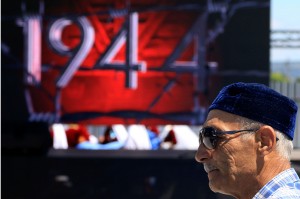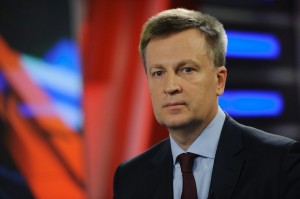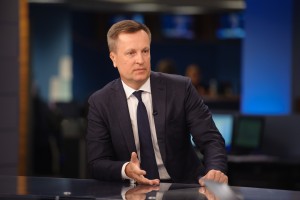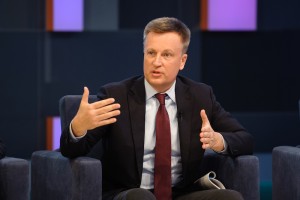April’s Digest

Atlantic Council, UkraineAlert: How Ukraine Can Win Back Crimea by Valentyn Nalyvaichenko.
Published Feb., 24, 2017
 Nalyvaichenko: The next step after a visa-free regime is to apply for the EU and NATO membership
Nalyvaichenko: The next step after a visa-free regime is to apply for the EU and NATO membership
“Ukrainian nationals have long deserved worthy travel to Europe: without visas, fees and waiting lines.
Visa-free regime is the first step. The second one is the Association Agreement with the EU. It’s time to show our determination and apply for the EU and NATO membership. We must give a straight answer to our partners that there is no alternative to our European integration. There is no return to corrupt practices”.
Nalyvaichenko called the decision taken by the European Parliament a fair one, but appealed to the authorities not to fall into euphoria of self-promotion.
“The most important for the Ukrainian leaders is to have a detailed plan that all the countries seeking the EU membership pursued. So the next step is the plan of the country’s development following the European scenario. The national changes plan, anticorruption reform and legislative amendments,” – the Justice movement leader underlined.
http://www.spravedlyvist.com.ua/news/6387
Published: April 6, 2017
 Nalyvaichenko: Unfortunately, our people are the poorest in Europe
Nalyvaichenko: Unfortunately, our people are the poorest in Europe
According to the IMF every Ukrainian can afford only 21 percent of what a European usually buys.
Human dignity in the EU is a citizen’s income level. In Ukraine there is humiliation of working and retired people – five times lower income, below the survival line.
The value of the market basket, we call it a Borshch Index by analogy to the BigMac Index, influences the level of living wage, and therefore all other social standards, guarantees, payments and benefits.
In accordance with the IMF expert calculations, not only haven’t we improved our living conditions in the recent years, but also declined 2-3 points. After the Revolution of Dignity our conditional Borshch is three times poorer than in our neighboring Lithuania, Estonia, and Poland. Their market basket keeps up at 70.
There have only been rhetorical “improvements”, manipulations and imitation of “deep” reform in our country during those three years.
But the reality is that only corruption and offshore network of the President’s team have deepened.
Ukrainian poverty alleviation means overcoming corruption and kleptocracy. We need those changes right here, right now.
Each of us.
Corrupt practices of Poroshenko, Gontareva, Kononenko left us far behind the countries that develop and make progress.
The income of Ukrainians is only 21% of the EU average.
Reference: Poverty index chart published on the IMF official website on April 4, 2017
http://vremya.eu/stati/politicheskie-stati/nalivaichenko-nash-lyudi-na-zhal-naib-dn.html
Published: April 7, 2017
 How Ukraine was loosing Crimea
How Ukraine was loosing Crimea
Valentyn Nalyvaichenko
SBU head from February 22, 2014 to June 18, 2015
How they together with Arsen Avakov were trying to track down fugitive Yanukovych in Crimea. How SBU Head of the Yanukovych’s times – Yakymenko – was fleeing from Kyiv to Crimea. What was the most destructive and made possible the capture of Crimea? On Russian military incursion into the Ukrainian territory. How SBU special task force evacuated Liubomyr Huzar from the occupied Crimea.
On the first arrest of the Russian intelligence officer who was preparing the invasion. On his exchange for Ukrainian captives, including commander of the Naval Forces Haiduk. Was it possible to save Crimea?
I am certain that the mechanism of Crimea’s annexation was set in motion by the Kharkiv agreements. The 2010 agreements were the ones to let Yanukovych and the parliament under his control allow Russia having 24,000 strong forces in Crimea.
These agreements abolished the mechanism of compulsory coordination of the Russian troops movement within the Crimean territory. The only mechanism left – and then only voluntary, instead of compulsory – to inform in case of leaving Ukraine or entering Ukrainian Crimea by additional or other units.
Moreover, Yanukovych and Khoroshkovskyi returned Russian FSB to Crimea in 2010.
First signs of something wrong going on in Crimea we noticed on the night of the 22nd to the 23rd of February. I – at that time still a deputy – and newly appointed legitimate Interior Minister Arsen Avakov went to Crimea by airplane. The Interior Ministry prepared all the procedural documents necessary for detention of the still incumbent president Yanukovych. I took that flight as an expert in covert operations.
The MIA plane with the transfer in Simferopol took us to Belbek. We thought that Yanukovych might be in one of his official state residencies.
We were met by three border guard officers. There were a couple of police officers with Avakov. About six to eight people, as far as I understand, from Crimean Chief Police Department and as I vividly remember six Crimean Alpha officers that fulfilled the order and arrived to the Belbek airport. We got into their vans where I gave first instructions in case of the operation and we headed to the presidential residency near Yalta.
We arrived. The night was far advanced. Arsen Avakov and I got out of the car, introduced ourselves, and said that we had the authority to arrest Yanukovych. We already understood then that the residency was empty. The Department of the State Guard (DSG) officers tasked with guarding the residency told us that he hadn’t even shown up there. We didn’t trust them, so we completed the search anyway.
After searching the residency in the early morning we arrived to the DSG regional office in Yalta. Two DSG officers of Yanukovych’s personal security detail carrying weapons and documents had arrived there right before us. During interrogation they told that Yanukovych had been on his way to Sevastopol at the time when we had just been about to take off from Kyiv.
They evidenced that before retreating to the Russian military base in Sevastopol Yanukovych had said that his further way was to Russia and had given the DSG officers a choice whether they followed him or stayed in Ukraine. Those two officers had decided to stay.
That’s what Avakov and me managed to find out by the morning of February 23.
And when we were crossing Crimea from Belbek to Yalta in search of Yanukovych the roads, the crossroads were already occupied by the Russian troops with their APCs. What was their purpose – it wasn’t evident back then, but it was clear that those were the Russian Black Sea Fleet units.
We had a specific task – Yanukovych tracing only. We didn’t have a possibility to figure out why Russian troops went out in the streets. I’m sure Avakov informed of the situation through his channels.
And after my return I urged at the Verkhovna Rada session that those were no self-defense forces – they were Russian regular troops in the streets and on the roads of Crimea.
And on February 24, 2014 around 6 p.m. the parliament appointed me the head of the SBU.
I entered the building on Volodymyrska Street late in the evening. It was empty. There was a site of fire in the courtyard – burnt documents. Desertion then reached the levels from the SBU head Yakymenko to chief department of national statehood protection Hanzha. Now I know that on February 22 Yakymenko took the private helicopter from Trukhanov Island to get to Crimea. Hanzha also fled to the peninsula.
Now we understand why Crimea.
Because a springboard for real annexation and further aggression towards South Ukraine had been prepared there.
All the Alpha weapons purchased ahead of the Euro-2012 were taken out to Crimea even before the Maidan. All the personnel records, as well as source records were also taken to Simferopol on Yakymenko’s order.
My first orders at the SBU were to detain Russian secret services in Crimea, put Alpha task force units to the positions, take government authorities under protection. But all in vain – chief of the SBU regional office in Sevastopol Petro Zyma and other local leaders gave opposite orders.
The FSB generals were already sitting at the SBU buildings and working as a part of the whole FSB in Crimea.
And that was really the most destructive moment as of February 23-25. All the Kyiv Alpha officers were subject to interrogations on the Maidan matter, weapons were withdrawn from them in order to make forensic examinations and find out where they were used to shoot activists or not.
Communication means didn’t work. To convey my orders I even used YouTube and television, where directly called Zyma high traitor and urged the officers not to obey him and those who remained true to the oath I encouraged to come back to the mainland Ukraine. Around 30% of the personnel remained faithful to the oath.
I was trying to get connected with the leadership of Crimea – still Ukrainian as we thought then – Kostiantynov and others. I urged them not to announce any sort of voting, warned against those inadmissible crimes, said that the SBU would counteract. The last time I spoke with Kostiantynov was about February 25. After that the connection disappeared at all.
On March 3, 2014 we already initiated a criminal case against high traitor Kostiantynov, and on March 6 – against high traitor Aksionov.
Meanwhile the mainland Ukraine was also torn by instability. Turchynov, Avakov, Nalyvaichenko, Pashynskyi, Senchenko were working day and night. Even at night we didn’t leave our working places. We didn’t go out because the situation remained burning at night and in the morning too.
There was Putin’s and the State Duma decision on military invasion into the Ukrainian territory taken on March 1. We understood that we must save Kyiv, and the whole country.
We were blocking key airports and takeoff runways in Zhuliany, Boryspil, Uzyn, Hostomil and all other airports around the capital. We understood that the aggressor was heading straight to Kyiv and was bringing Yanukovych for “coronation”. From Belgorod and other directions Russian military helicopters, convoys of armored vehicles were coming along and even crossing our border – real military invasion.
And so it was every night until mid-April.
TASK FORCE OPS IN CRIMEA
On February 25-26 I began structuring special task groups in Kyiv to be sent to Crimea. Neither South, nor East regional offices of the SBU were informed about them.
Today we finally can talk about it. The task was to catch traitors.
Another task was to arrest officers of the Russian secret services who had been operating in Ukrainian Crimea. The groups had to bring them to Kyiv. It would have been a clear evidence of the Russian aggression with the use of Russian secret and military agencies in our territory.
The third task: there were a lot of Ukrainian public figures and church leaders. We had to save them.
For example, at the beginning of March we managed to evacuate His Beatitude Liubomyr Husar. He had been settling his affairs there when we found out that the FSB had taken an interest in him. Our officers then managed to find a contact and get in touch with the nurse who accompanied him. So one of our groups saved them, transferred them to Kyiv via Kherson Region.
The FSB began taking hostages from among the Ukrainian patriots. A lot of people were heading to Crimea those days not knowing yet that there were Russian troops and the FSB. Russian secret services put filtration patrols at the railway stations.
They had photos, passport copies, phone numbers. So they were flicking people out as hostages.
Our special groups were tasked with releasing them. One of the successful operations was the release of a group with Oleksii Hrytsenko and commander-in-chief of the Ukrainian Naval Forces Haiduk on March 20.
The special task groups also had to retrieve state secret information from Crimea. We managed to rescue personnel and source records of the SBU. A covert operation was conducted, the documents were taken from Crimea to Mykolaiv, and from Mykolaiv to Kyiv.
We weren’t aware of the preparation to seizure of the parliament building that took place on the night of March 26th to 27th. We didn’t have any opportunity to receive that information.
It wasn’t really a seizure, it was a task given from the parliament building. We managed to obtain a video of progression of events inside the parliament building. It shows how Crimean Police that was supposed to protect the parliament handed the weapons over to the Russian special operations forces that entered the parliament with machine-guns and assault rifles.
It was a disappointment and tragedy for us to realize that our orders were not only ignored in Crimea, but also instead of using weapons against the invader our forces passed them to the aggressor becoming collaborators.
Our special task groups weren’t enough to regain control. That’s why we used them for pinpoint targets.
ARREST OF THE GRU OFFICER
One of our groups during a combat mission detained chief of the Russian GRU sabotage group colonel Nefedov in Kherson Region not far from Crimea. He was arrested and taken to Kyiv.
He wasn’t the only one, we didn’t mention them at that time, but interrogated and passed to the prosecutor’s office.
His group was tasked with preparing the invasion. He was arrested as a leader of the group right in the middle of that preparation. That was one of the first significant proofs of the Russian military aggression. In addition, he was the source of information about Russia’s plans.
It was then that I first realized that in no time we would face a problem of releasing our nationals from captivity. That’s why as much as possible we focused on arresting terrorists, saboteurs, Russian secret agents. Several times the exchange was about to take place, including the group of captives with Oleksii Hrytsenko. We understood that the issue reached Putin personally.
We planned the exchange with Andrii Senchenko. I took a tough stance, if the exchange of that Russian colonel was to take place – only in Kyiv then. Because at Chonhar they could simply take him and shoot our people without giving out the hostages.
So we decided to hand the GRU officer over to the Russians in Kyiv via the Russian embassy. But the handover was to be accomplished only after the bus with Ukrainian activists crosses the administrative border and the commander of the Naval Forces Haiduk makes it to the territory under Ukrainian control.
Andrii Senchenko was very brave to go the Russian embassy, I must give him credit for that, and did everything right in order for us not to give the colonel out prior the AutoMaidan activists were released.
Needless to say that before releasing the Russian colonel we interrogated him. He told us everything he could. His interrogation record is attached to the criminal case regarding the Russian aggression against Ukraine. I really hope that the International Court in Hague would use both the video and the audio files.
Was it possible to save Crimea in that situation? The aggressor didn’t give us a single chance. The aggressor together with Yanukovych, Yakymenko, 2014 defense minister Lebediev gave us no chance.
Speaking about Alpha unit, and other SBU divisions, as of 2014 all of them were infiltrated with the Russian ideology and secret service agent network to the extent that they strongly believed that Russia was not the aggressor and wondered why should they shoot the Russian brothers!
The key factor of returning Crimea is its indigenous people – Crimean Tatars. The second one is tenable Ukrainian army. The third is Ukrainian government authorities of Crimea.
And it is possible, and necessary to create them in our territory – it was right to create the Crimean prosecutor’s office, we did right when created new Crimean regional office of the SBU straight away.
That’s the only way to return Crimea.
Published: April 10, 2017

 Facebook
Facebook Twitter
Twitter Linkedin
Linkedin